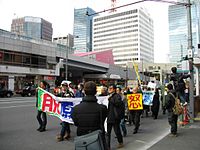
2011 Tōhoku earthquake and tsunami
On 11 March 2011, at 14:46 JST (05:46 UTC), a Mw 9.0–9.1 undersea megathrust earthquake occurred in the Pacific Ocean, 72 km (45 mi) east of the Oshika Peninsula of the Tōhoku region. It lasted approximately six minutes, causing a tsunami. It is sometimes known in Japan as the "Great East Japan Earthquake" (東日本大震災, Higashi nihon daishinsai), among other names.[en 1] The disaster is often referred to by its numerical date, 3.11 (read san ten ichi-ichi in Japanese).[30][31][32]
"2011 Miyagi earthquake" and "3.11" redirect here. For the aftershock that occurred on 7 April, see April 2011 Miyagi earthquake. For other uses, see 3/11 (disambiguation).UTC time
2011-03-11 05:46:24
11 March 2011
14:46:24 JST
6 minutes
9.0–9.1 Mw
29 km (18 mi)
Convergent boundary between Pacific Plate and Okhotsk microplate[1]
- Japan (shaking, tsunami)
- Pacific Rim (tsunami)
$360 billion USD
117.41 cm/s
Yes
13,386 (as of 6 March 2018)[4]
It was the most powerful earthquake ever recorded in Japan, and the fourth most powerful earthquake recorded in the world since modern seismography began in 1900.[33][34][35] The earthquake triggered powerful tsunami waves that may have reached heights of up to 40.5 meters (133 ft) in Miyako in Tōhoku's Iwate Prefecture,[36][37] and which, in the Sendai area, traveled at 700 km/h (435 mph)[38] and up to 10 km (6 mi) inland.[39] Residents of Sendai had only eight to ten minutes of warning, and more than a hundred evacuation sites were washed away.[38] The snowfall which accompanied the tsunami[40] and the freezing temperature hindered rescue works greatly;[41] for instance, Ishinomaki, the city with the most deaths,[42] was 0 °C (32 °F) as the tsunami hit.[43] The official figures released in 2021 reported 19,759 deaths,[44] 6,242 injured,[45] and 2,553 people missing,[46] and a report from 2015 indicated 228,863 people were still living away from their home in either temporary housing or due to permanent relocation.[47]
The tsunami caused the Fukushima Daiichi nuclear disaster, primarily the meltdowns of three of its reactors, the discharge of radioactive water in Fukushima and the associated evacuation zones affecting hundreds of thousands of residents.[48][49] Many electrical generators ran out of fuel. The loss of electrical power halted cooling systems, causing heat to build up. The heat build-up caused the generation of hydrogen gas. Without ventilation, gas accumulated within the upper refueling hall and eventually exploded causing the refueling hall's blast panels to be forcefully ejected from the structure. Residents within a 20 km (12 mi) radius of the Fukushima Daiichi Nuclear Power Plant and a 10 km (6.2 mi) radius of the Fukushima Daini Nuclear Power Plant were evacuated.
Early estimates placed insured losses from the earthquake alone at US$14.5 to $34.6 billion.[50] The Bank of Japan offered ¥15 trillion (US$183 billion) to the banking system on 14 March 2011 in an effort to normalize market conditions.[51] The World Bank's estimated economic cost was US$235 billion, making it the costliest natural disaster in history.[52][53] According to a 2020 study, "the earthquake and its aftermaths resulted in a 0.47 percentage point decline in Japan's real GDP growth in the year following the disaster."[54]
The aftermath of the earthquake and tsunami included a humanitarian crisis and a major economic impact. The tsunami resulted in over 340,000 displaced people in the Tōhoku region, and shortages of food, water, shelter, medicine, and fuel for survivors. In response, the Japanese government mobilized the Self-Defence Forces (under Joint Task Force – Tōhoku, led by Lieutenant General Eiji Kimizuka), while many countries sent search and rescue teams to help search for survivors. Aid organizations in Japan and worldwide responded, with the Japanese Red Cross reporting $1 billion in donations. The economic impact included immediate problems, with industrial production suspended in many factories, and the longer term issue of the cost of rebuilding, which has been estimated at ¥10 trillion ($122 billion). In comparison to the 1995 Great Hanshin earthquake, the East Japan earthquake brought serious damage to an extremely wide range.[385]
The aftermath of the twin disasters left Japan's coastal cities and towns with nearly 25 million tons of debris. In Ishinomaki alone, there were 17 trash collection sites 180 metres (590 ft) long and at least 4.5 metres (15 ft) high. An official in the city's government trash disposal department estimated that it would take three years to empty these sites.[386]
In April 2015, authorities off the coast of Oregon discovered debris that was thought to be from a boat destroyed during the tsunami. The cargo contained yellowtail amberjack, a species of fish that lives off the coast of Japan, still alive. KGW estimates that more than 1 million tons of debris still remain in the Pacific Ocean.[387]
In February 2016, a memorial was inaugurated by two architects for the victims of the disaster, consisting of a 6.5-square-metre structure on a hillside between a temple and a cherry tree in Ishinomaki.[388]
Documentaries and commemoration events
Sources
![]() This article incorporates text from a free content work. Licensed under Cc BY-SA 3.0 IGO (license statement/permission). Text taken from Drowning in Plastics – Marine Litter and Plastic Waste Vital Graphics, United Nations Environment Programme.
This article incorporates text from a free content work. Licensed under Cc BY-SA 3.0 IGO (license statement/permission). Text taken from Drowning in Plastics – Marine Litter and Plastic Waste Vital Graphics, United Nations Environment Programme.

